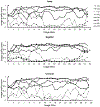Automated image quality evaluation of structural brain MRI using an ensemble of deep learning networks
- PMID: 30811739
- PMCID: PMC6711839
- DOI: 10.1002/jmri.26693
Automated image quality evaluation of structural brain MRI using an ensemble of deep learning networks
Abstract
Background: Deep learning (DL) is a promising methodology for automatic detection of abnormalities in brain MRI.
Purpose: To automatically evaluate the quality of multicenter structural brain MRI images using an ensemble DL model based on deep convolutional neural networks (DCNNs).
Study type: Retrospective.
Population: The study included 1064 brain images of autism patients and healthy controls from the Autism Brain Imaging Data Exchange (ABIDE) database. MRI data from 110 multiple sclerosis patients from the CombiRx study were included for independent testing.
Sequence: T1 -weighted MR brain images acquired at 3T.
Assessment: The ABIDE data were separated into training (60%), validation (20%), and testing (20%) sets. The ensemble DL model combined the results from three cascaded networks trained separately on the three MRI image planes (axial, coronal, and sagittal). Each cascaded network consists of a DCNN followed by a fully connected network. The quality of image slices from each plane was evaluated by the DCNN and the resultant image scores were combined into a volumewise quality rating using the fully connected network. The DL predicted ratings were compared with manual quality evaluation by two experts.
Statistical tests: Receiver operating characteristic (ROC) curve, area under ROC curve (AUC), sensitivity, specificity, accuracy, and positive (PPV) and negative (NPV) predictive values.
Results: The AUC, sensitivity, specificity, accuracy, PPV, and NPV for image quality evaluation of the ABIDE test set using the ensemble model were 0.90, 0.77, 0.85, 0.84, 0.42, and 0.96, respectively. On the CombiRx set the same model achieved performance of 0.71, 0.41, 0.84, 0.73, 0.48, and 0.80.
Data conclusion: This study demonstrated the high accuracy of DL in evaluating image quality of structural brain MRI in multicenter studies.
Level of evidence: 3 Technical Efficacy: Stage 2 J. Magn. Reson. Imaging 2019;50:1260-1267.
Keywords: brain MRI; deep learning; postprocessing; quality assessment.
© 2019 International Society for Magnetic Resonance in Medicine.
Figures






References
Publication types
MeSH terms
Grants and funding
LinkOut - more resources
Full Text Sources
Other Literature Sources
Medical
Research Materials

